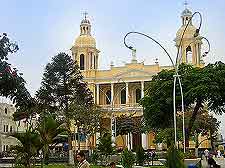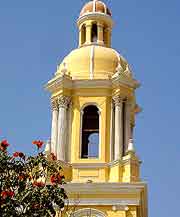Chiclayo History Facts and Timeline
(Chiclayo, Lambayeque, Peru)

The capital of northern Peru's Lambayeque region, Chiclayo contains the fourth-biggest population of any city in the country.
The 700,000 people who live here are so welcoming and friendly, that the city is now affectionately called the 'Capital of Friendship'. Chiclayo lies just 13 km / 8 miles inland from the shoreline of the Pacific Ocean and its plazas are filled with activity, well after the sun goes down.
Moche and Lambayeque Cultures
The Moche was the oldest known civilisation in the history of Chiclayo, reigning over Peru's north coast for some seven centuries from 100 AD onwards. The Moche's well-developed irrigation system was as intricate and as well-known as the stylised art work covering their beautiful ceramics.
Chiclayo's next dominant culture, the Lambayeque, occupied the area from 700 AD until the latter part of the 14th century. The Lambayeque adopted many Moche customs and were most famous for their elaborate gold jewellery, accomplished building techniques and well-developed navigational skills. One of the city's oldest archaeological sites, the ruins of Northern Wari, dates from this period in the history of Chiclayo.
Spanish Mule Watering Spot
Unlike most other large Peruvian cities, Chiclayo was relatively undeveloped by Spanish conquistadors, who mainly stopped in this small community to water their animals on journeys between the then bigger, but now largely abandoned, communities of Ferrenafe, Lambayeque and also Zana. Most residents belonged to either the Collique or the Cinto civilisations, which have firm origins in the early part of the 16th century.

Heroic City
At the time of the Peruvian War of Independence (1809 to 1824), the community remained a sparsely populated village. However, Chiclayo was well rewarded after providing horses and weaponry, as well as military troops and other valuable resources to supporters of the revolution. Chiclayo was hailed a 'Heroic City' in 1835 and became the capital of its newly created namesake province the following day.
History of Modern Times
Today, Chiclayo has overcome its humble beginnings to become northern Peru's commercial hub, while many of its surrounding communities are now little more than ghost towns. Unfortunately, the Parque Principal witnessed the city's historic municipal building burn down in 2006, while the heavy and very seasonal 'El Nino' rainfall has greatly damaged Chiclayo's original El Convenio San Maria convent, once the city's most important building.
The late 19th-century La Verónica and La Catedral churches, however, still stand in their original splendour as visual reminders of the more recent history of Chiclayo. The city's most unusual tourist attraction is perhaps its witches' market, where visitors can purchase magical amulets and potions.
The layouts of several Chiclayo streets are based on the winding farmers' lanes of its rural past. Greco-Roman statues line the popular Paseo Las Musas promenade, where Egyptian figures hold up its triumphal arch.
 The capital of northern Peru's Lambayeque region, Chiclayo contains the fourth-biggest population of any city in the country.
The capital of northern Peru's Lambayeque region, Chiclayo contains the fourth-biggest population of any city in the country.